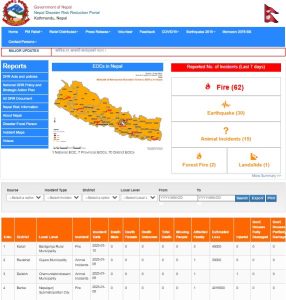IN A NUTSHELL Editor's NoteThe piece here is an excerpt from the final manuscript ‘Health Sector Disaster Management Handbook: Nepal’, just edited by the Author, which is soon going to print.
As in the Executive Summary, the Handbook ‘…serves as a comprehensive guide for enhancing Nepal’s health sector preparedness, response, recovery, and resilience in the face of disasters and public health emergencies. Given Nepal's unique geographical, socio-political, and environmental context, the health sector faces growing risks from natural hazards, climate change, disease outbreaks, and technological accidents…’ As the Author maintains ‘It is designed as a comprehensive, context-specific guide for health professionals, policymakers, emergency responders, development partners, and community actors seeking to build a robust and resilient health system that can withstand and respond to the multifaceted challenges posed by disasters’. Please refer to the Author for in-depth information over of the entire work
Executive Director SIMEX Hub
Nepal
Climate Change and Health Disasters/Risks in Nepal
Climate Change and Health Disasters
The impacts of climate change in Nepal are becoming increasingly evident, with rising temperatures, erratic rainfall patterns, and melting glaciers.
- Vector-Borne Diseases: Warmer temperatures and changing rainfall patterns expand the habitats of disease vectors like mosquitoes, leading to increased cases of malaria, dengue, and other vector-borne illnesses.
- Food Security: Erratic weather affects agricultural productivity, contributing to malnutrition and associated health issues.
Epidemics and Public Health Emergencies
Nepal’s public health system is periodically strained by outbreaks of infectious diseases.
- Cholera and Waterborne Diseases: Frequent outbreaks are linked to poor water quality and inadequate sanitation, particularly during floods.
- COVID-19 Pandemic: The global pandemic highlighted systemic vulnerabilities, such as limited critical care infrastructure, shortages of medical supplies, and inequitable healthcare access.
Conclusion
Nepal’s vulnerability to disasters stems from a combination of geographic, climatic, and socio-economic factors. Each type of disaster presents unique challenges to the health sector, necessitating a robust disaster management system. The following chapters will explore strategies for mitigating these risks, strengthening health system resilience, and ensuring effective disaster response and recovery.
Climate Change and Health Risks
Introduction
Climate change poses significant risks to public health, particularly in Nepal, where its diverse geography and socio-economic vulnerabilities amplify the effects. Rising temperatures, erratic rainfall patterns, and extreme weather events contribute to increased disease burdens, infrastructural damage, and significant strain on healthcare systems across the country.
Health Impacts of Climate Change
Over the past five decades, Nepal has experienced an average temperature increase of 0.06°C per year, with higher rates of warming observed in the Himalayan region and urban centers. This warming has intensified urban heat islands in cities like Kathmandu and Pokhara, leading to an increase in heat-related illnesses such as heatstroke and dehydration. Vulnerable groups including the elderly, outdoor workers, and those with pre-existing medical conditions are particularly at risk.
Monsoon floods regularly inundate large areas of the Terai region, affecting millions of people and disrupting essential health services. The devastating floods of 2024 impacted over 200 health facilities nationwide, including the complete submersion of the Susta Pari health post. In the aftermath of such floods, waterborne diseases such as diarrhea, cholera, and typhoid surge significantly, with cases rising by 30-40% in the affected areas.
Vector-borne diseases also pose a growing threat as climate change alters mosquito breeding patterns. In 2023, Nepal saw a surge in dengue infections with over 50,000 reported cases, largely driven by climate- induced environmental changes. Additionally, rising temperatures have expanded malaria transmission to higher altitude regions previously unaffected by the disease, posing new challenges for disease control.
Air pollution, especially in Kathmandu, frequently exceeds World Health Organization limits, worsening respiratory tract infections, asthma, and cardiovascular diseases. During dry seasons, wildfires and droughts increase particulate matter (PM2.5) in the air, resulting in a 20- 30% rise in respiratory hospitalizations.
Climate-Resilient Health Strategies
Figure: DRR portal
To address these challenges, several climate-resilient strategies are essential. Urban areas should develop heatwave response plans by establishing cooling centers during peak summer months, running public awareness campaigns about hydration and heatstroke prevention, and implementing green urban planning initiatives that increase tree cover to mitigate heat island effects.
In the flood-prone Terai region, health posts need to be floodproofed by elevating infrastructure above historical flood levels, equipping facilities with solar-powered emergency backups to ensure uninterrupted services, and pre-positioning medical supplies in vulnerable areas to maintain readiness during disasters.
Strengthening early warning systems for climate-sensitive diseases is also critical. This includes enhancing disease surveillance through climate modeling to predict outbreaks of malaria, dengue, and cholera, implementing SMS-based alerts to inform high-risk communities, and expanding integrated vector management alongside community-based health interventions.
Conclusion
Climate change presents an urgent public health challenge that requires proactive and evidence-based responses. By integrating climate resilience into Nepal’s health systems, it is possible to mitigate the associated risks and ensure sustainable healthcare access for the country’s most vulnerable populations.

